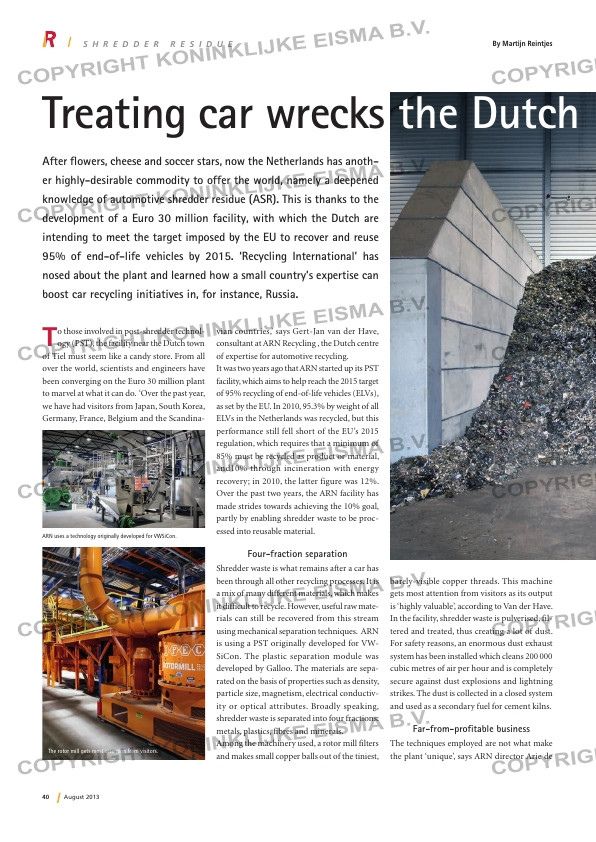Page 40 from: August 2013

40 August 2013
After flowers, cheese and soccer stars, now the Netherlands has anoth-
er highly-desirable commodity to offer the world, namely a deepened
knowledge of automotive shredder residue (ASR). This is thanks to the
development of a Euro 30 million facility, with which the Dutch are
intending to meet the target imposed by the EU to recover and reuse
95% of end-of-life vehicles by 2015. ‘Recycling International’ has
nosed about the plant and learned how a small country’s expertise can
boost car recycling initiatives in, for instance, Russia.
To those involved in post-shredder technol-ogy (PST), the facility near the Dutch town
of Tiel must seem like a candy store. From all
over the world, scientists and engineers have
been converging on the Euro 30 million plant
to marvel at what it can do. ‘Over the past year,
we have had visitors from Japan, South Korea,
Germany, France, Belgium and the Scandina-
barely-visible copper threads. This machine
gets most attention from visitors as its output
is ‘highly valuable’, according to Van der Have.
In the facility, shredder waste is pulverised, fil-
tered and treated, thus creating a lot of dust.
For safety reasons, an enormous dust exhaust
system has been installed which cleans 200 000
cubic metres of air per hour and is completely
secure against dust explosions and lightning
strikes. The dust is collected in a closed system
and used as a secondary fuel for cement kilns.
Far-from-profitable business
The techniques employed are not what make
the plant ‘unique’, says ARN director Arie de
S h r e d d e r r e S i d u e By Martijn Reintjes
Treating car wrecks the Dutch way
vian countries,’ says Gert-Jan van der Have,
consultant at ARN Recycling , the Dutch centre
of expertise for automotive recycling.
It was two years ago that ARN started up its PST
facility, which aims to help reach the 2015 target
of 95% recycling of end-of-life vehicles (ELVs),
as set by the EU. In 2010, 95.3% by weight of all
ELVs in the Netherlands was recycled, but this
performance still fell short of the EU’s 2015
regulation, which requires that a minimum of
85% must be recycled as product or material,
and10% through incineration with energy
recovery; in 2010, the latter figure was 12%.
Over the past two years, the ARN facility has
made strides towards achieving the 10% goal,
partly by enabling shredder waste to be proc-
essed into reusable material.
Four-fraction separation
Shredder waste is what remains after a car has
been through all other recycling processes. It is
a mix of many different materials, which makes
it difficult to recycle. However, useful raw mate-
rials can still be recovered from this stream
using mechanical separation techniques. ARN
is using a PST originally developed for VW-
SiCon. The plastic separation module was
developed by Galloo. The materials are sepa-
rated on the basis of properties such as density,
particle size, magnetism, electrical conductiv-
ity or optical attributes. Broadly speaking,
shredder waste is separated into four fractions:
metals, plastics, fibres and minerals.
Among the machinery used, a rotor mill filters
and makes small copper balls out of the tiniest,
The rotor mill gets most attention from visitors.
ARN uses a technology originally developed for VWSiCon.
RI-6_ARN.indd 40 01-08-13 15:58



